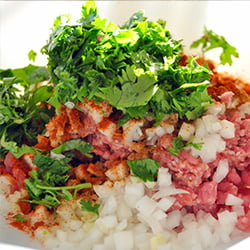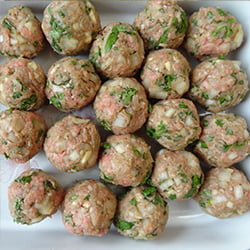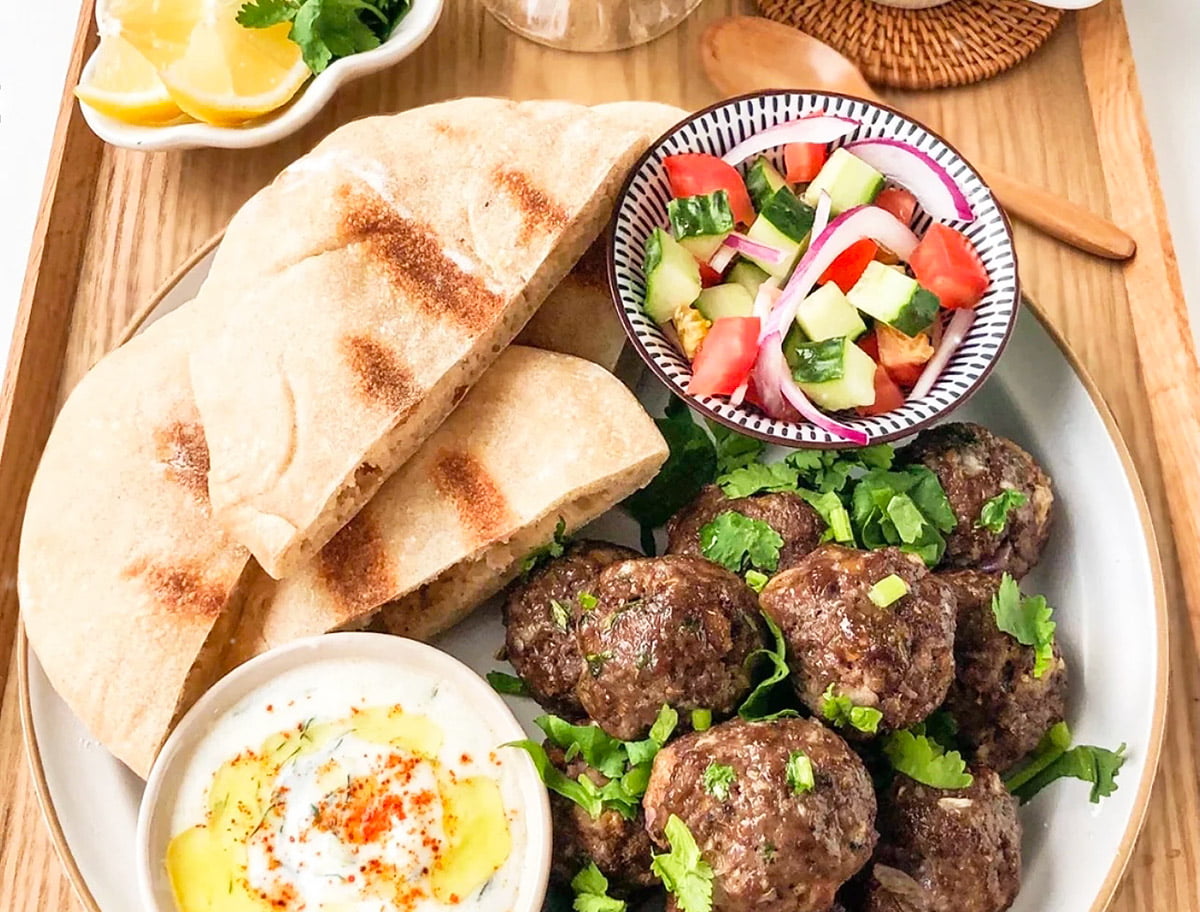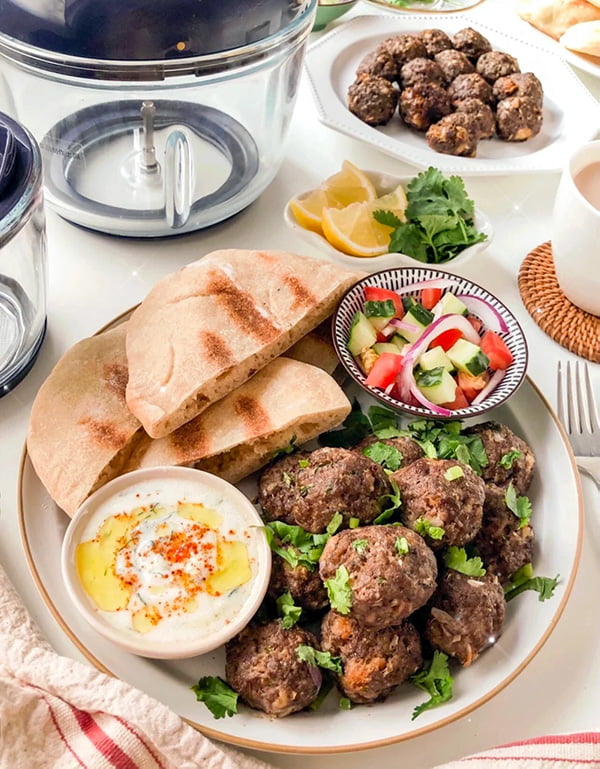Kafta, also known as Kofta or Kofte, is a culinary treasure that boasts a rich history and an array of tantalizing flavors. With its roots deeply embedded in Middle Eastern cuisine, this delightful dish symbolizes hospitality, warmth, and togetherness.
Originating from the Levantine region, which includes countries like Lebanon, Syria, and Jordan, Kafta is a beloved dish that showcases the rich cultural heritage and culinary traditions of this vibrant part of the world. With a history dating back centuries, Kafta has stood the test of time and continues to be cherished by generations, both within the Middle East and beyond.
In this post, I will share a healthy and delicious Lebanese beef kafta recipe and a step-by-step guide for making beef Kafta kabobs.
Kafta Kabob Recipe
Prep Time
10 minutes
Cook Time
20 minutes
Rest Time
35 minutes
Total Time
65 minutes
Ingredients
Directions
1. If a food processor is available, you can place onion, garlic, mint, and parsley in the food processor and pulse them until they are finely chopped. If a food processor is unavailable, you will want to chop them finely.

2. combine the ground beef, chopped onion, minced garlic, chopped parsley, mint, cumin, coriander, paprika, cinnamon, salt, and pepper in a large bowl. Thoroughly blend the ingredients, ensuring even distribution of the spices within the meat mixture.
3. After achieving a well-combined mixture, cover the bowl and refrigerate it for at least 30 minutes. This step allows the flavors to meld together and makes the meat easier to handle when shaping the Kafta.
4. Begin by preheating your grill to medium-high heat, or alternatively, preheat your oven.

5. While the grill is heating up, take small portions of the meat mixture and shape them into long, thin cylinders around metal skewers or small oval-shaped patties. The thickness of the Kafta is a matter of personal preference, but the aim is to have an approximate 1/2-inch to 3/4-inch thickness to ensure even cooking.
6. Once your Kafta skewers or patties are ready, lightly brush them with high smoke point oil to prevent sticking and add a hint of extra flavor. Place the Kafta on the preheated grill or in the oven, ensuring there is enough space between them for even cooking.
7. You can either grill or bake kafta.
Grill: Grill the Kafta for approximately 4-6 minutes per side, either on an outdoor grill pan or indoor electric grill, until the meat is thoroughly cooked and develops a slight char on the outside. Take care when flipping the Kafta to prevent them from breaking apart.
Baking: Bake the patties at 350 degrees for about 15-20 minutes
8. Once they are cooked to the desired doneness, remove the Kafta from the grill or oven and let them rest for a few minutes. This allows the juices within the meat to redistribute, resulting in a moist and flavorsome outcome.
9. Serve the Kafta hot with your choice of accompaniments. They can be enjoyed as a main course with rice or salad, wrapped in warm pita bread with tahini sauce and fresh vegetables, or as part of a mezze platter alongside hummus, tabbouleh, and other Middle Eastern delicacies.
Tips & Notes
Resting Time: Give the meat mixture at least 30 minutes to rest in the refrigerator before shaping it. This process aids in blending the flavors harmoniously and enhances the manageability of the mixture.
Skewering or Shaping: If you use metal or wooden skewers, ensure they are thoroughly soaked in water for approximately 30 minutes before skewering the meat. This prevents them from burning during grilling. Wet your hands with water or olive oil to prevent sticking when shaping the beef Kafta into patties or cylinders.
Cooking Time: Watch the beef Kafta while grilling or broiling, as cooking times may vary depending on the thickness and heat intensity. Turn the kafta gently to avoid breakage, and cook until it is cooked with a slightly charred exterior.
Nutritional Facts
Nutrition Facts
Servings: "2"
Calories
201
% Daily Value*
Total Fat "7.1g"
"9%"
Saturated Fat "1g"
"5%"
Cholesterol "0mg"
"0%"
Sodium "233mg"
"10%"
Total Carbohydrate "34.2g"
"12%"
Dietary Fiber "4.2g"
"15%"
Total Sugars "20.1g"
"0%"
Protein "1.9g"
"0%"
Vitamin D "0mcg"
"0%"
Calcium "46mg"
"4%"
Iron "3mg"
"14%"
Potassium "604mg"
"13%"
*The % Daily Value (DV) tells you how much a nutrient in a food serving contributes to a daily diet. 2,000 calorie a day is used for general nutrition advice.
Finely Chopped Ingredients: Invest the necessary time to finely chop the onions, garlic, parsley, and mint. This ensures an even distribution of flavors throughout the Kafta mixture.
Use a Food Processor: To make mixing easy, run all the ingredients in the food processor on a pulse.

What Is Kafta
Known as Kafta in Lebanon and Kofta in other Middle Eastern Countries, it is a versatile dish made with ground beef. However, you can also find this dish made with a ground meat mixture that combines both ground beef and lamb.
Kafka's origins can be traced back centuries, with variations found across different Middle Eastern countries, each with its own unique twist. The beauty of Kafta lies in its simplicity; it's a dish that celebrates the natural flavors of quality meat combined with aromatic spices and fresh herbs.
Kafta can be served as a main course, accompanied by fragrant rice, grilled vegetables, or salad. It is also commonly enjoyed as street food, where the grilled Kafta is wrapped in warm pita bread, along with fresh vegetables, pickles, and a drizzle of flavorful sauces such as tahini or garlic sauce.
Kafta Shapes
Skewered Kafta
Skewered Kafta or Kafta Kabob is one of this dish's classic and iconic forms. The meat mixture is molded into long, thin cylinders around metal skewers. This shape allows for even cooking and provides a beautiful presentation. The elongated shape makes it easy to handle and turn the Kafta while grilling. Skewered Kafta is commonly presented as a satisfying main course and can be relished either on its own or accompanied by flavorful additions like rice, grilled vegetables, or salads.
Patties
Kafta can also be shaped into small oval patties or meatballs. This Middle Eastern meatball adapts well to a variety of cooking methods, including grilling, pan-frying, or baking. Patties offer more surface area for browning, creating a flavorful crust while maintaining a juicy interior. They are versatile and can be used in a variety of dishes, like sandwiches and wraps, or as a component of mezze platters.
What Ingredients You Will Need To Make Kafta
Ground Beef
In this recipe, we used 90% lean ground beef, but feel free to select any fat level or even different meats according to your preference. The juiciness of kafta increases with the fat content in the beef. Alternatively, ground lamb is a popular choice, known for its rich flavor. You can use it alone or mix it with beef to enhance the taste and texture. The key is to balance the fat-to-lean ratio to ensure your kafta is both moist and flavorful. A mixing of lamb and beef is commonly found in a traditional Lebanese kafta recipe, offering a robust and hearty flavor profile.
Onion
The onion adds a savory and sweet note to the Kafta mixture. It also contributes moisture and aids in binding the ingredients together. Finely chopped onion distributes its flavor evenly throughout the meat.
Garlic
Garlic adds a distinct and aromatic flavor to the beef Kafta. It is minced and mixed with ground beef. Garlic enhances the overall taste profile and complements the other spices and herbs.
Fresh Parsley
Fresh parsley brings a vibrant, herbaceous flavor to the beef Kafta. It is finely chopped and introduced into the ground beef. Parsley adds a fresh and bright element to the dish, balancing the meat's richness.
Fresh Mint
Fresh mint leaves contribute a refreshing and cooling flavor to the beef Kafta. Like parsley, mint is finely chopped and combined with the ground beef. Mint offers a delightful contrast and harmonizes with the other seasonings, enhancing the overall flavor.
Middle Eastern Spices
Various spices elevate the flavor profile of beef Kafta. Here are the Middle Eastern spices we recommend and the most commonly used spices blend to use in beef Kafta:
Ground Cumin
Cumin is a warm, earthy spice that adds depth and complexity to the beef Kafta. Its subtly smoky and nutty flavor elevates the dish's overall taste experience.
Ground Coriander
Coriander is a versatile spice with citrusy and floral undertones. It harmonizes beautifully with the other spices, infusing the beef Kafta with a delightful aroma.
Ground Paprika
Paprika is a spice created by drying and grinding red bell peppers. It contributes a mild sweetness, vibrant color, and a hint of smokiness to the beef Kafta.
Ground Cinnamon
Cinnamon, a warm and aromatic spice, imparts a delicate sweetness and complexity to the beef Kafta, adding a delightful dimension to the overall flavor profile.
Salt And Pepper
Salt and pepper play a vital role as essential seasonings, enhancing the flavors of the other ingredients. They should be added according to taste preferences.
Olive Oil
Olive oil contributes to the moisture and tenderness of the beef Kafta. Adding oil helps prevent the meat mixture from drying during grilling. It ensures that the Kafta remains juicy and succulent. Brushing the beef Kafta before grilling and baking can help prevent sticking, add a hint of richness, and help achieve a beautiful char on the exterior.

Frequently Asked Questions (FAQ)
Can I Use A Different Meat If I Don't Eat Lamb Or Beef?
Yes, you can customize Kafta to your preferences. Ground chicken, turkey, or plant-based alternatives like vegetarian ground "meat" can be viable substitutes.
How Do I Prevent Kafta From Falling Apart On The Grill?
Proper shaping and handling are important to prevent Kafta from falling apart. Ensure that the meat mixture is thoroughly blended and compacted. If using skewers, mold the meat tightly around them. Wetting your hands with water or oil while shaping can also help prevent sticking and maintain the shape.
If wooden skewers are being used, it's best to soak them overnight to prevent them from burning on the grill.
Can You Pan Fry Kafta?
Yes, you can pan fry kafta! Pan fry the Kafta over medium-high heat for approximately 4-6 minutes per side or until it is fully cooked and achieves a desirable golden brown color.
How To Store Leftover Kafta
If you have leftovers on the skewers, remove the Kafta and transfer them to a separate container. This simplifies the storage process and safeguards the skewers from any potential damage.
Place the leftover Kafta in an airtight container or wrap it tightly with plastic wrap and then place it in the refrigerator. It is recommended that the remaining Kafta be consumed within 3-4 days. Although it might still be safe to eat beyond this period, the quality and flavor may diminish.
